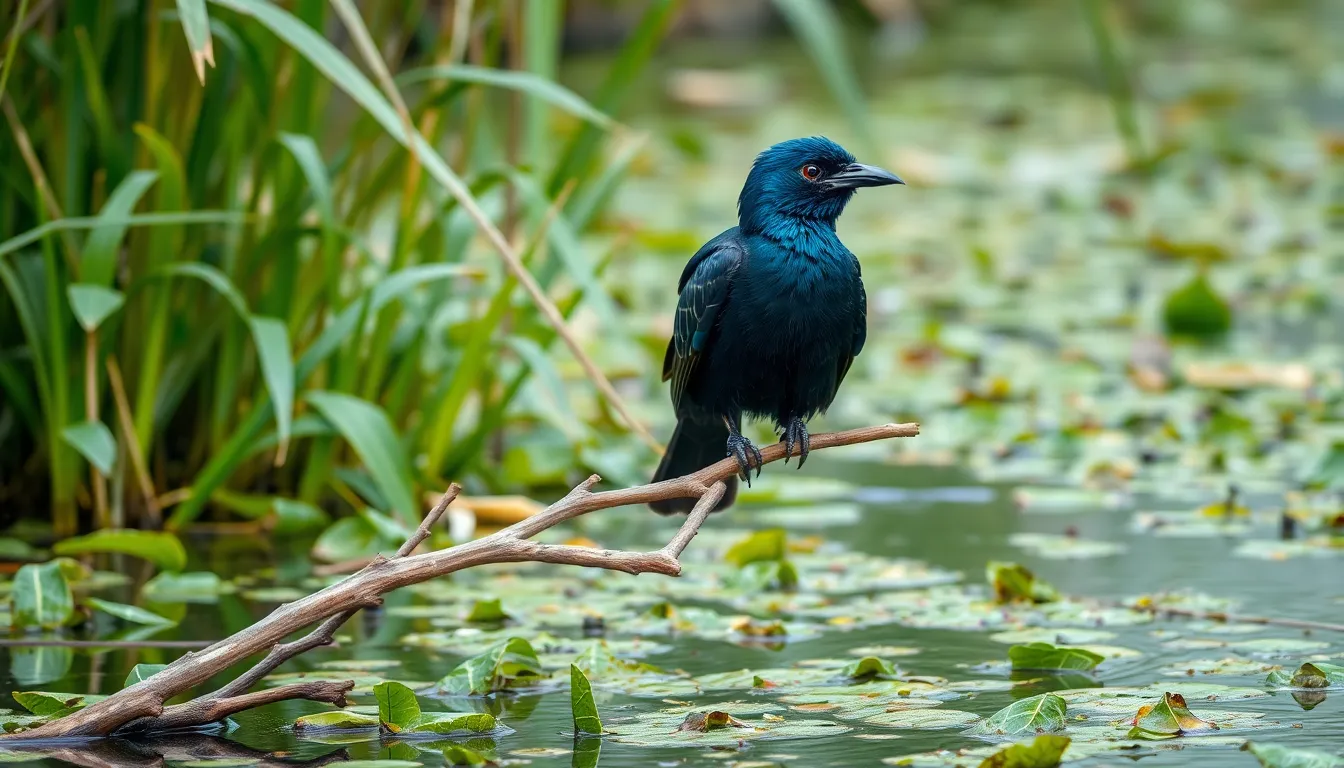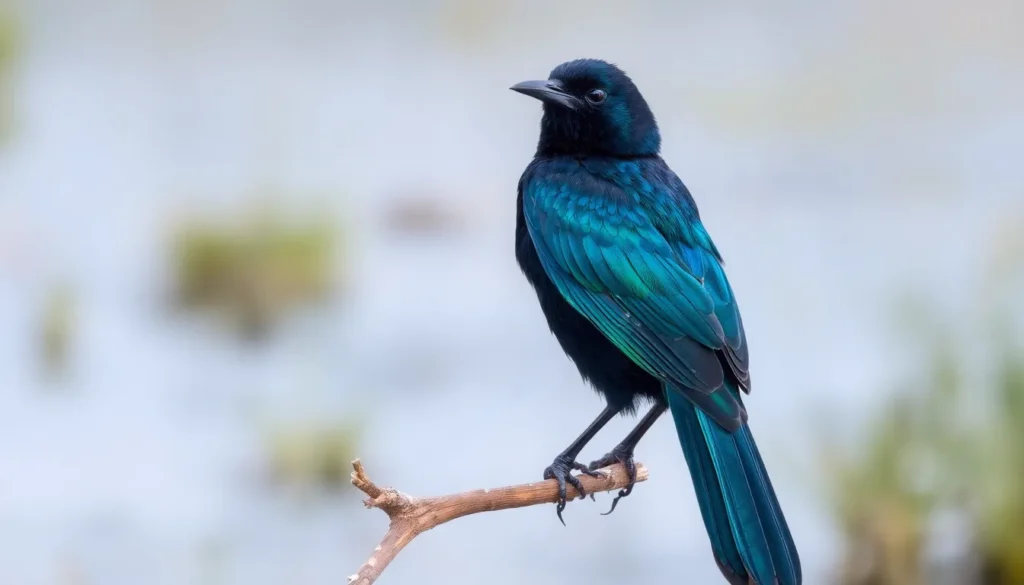In the world of avian beauty, few sights are as striking as a black bird adorned with a shimmering blue tint. These captivating creatures often turn heads and spark curiosity among birdwatchers and nature enthusiasts alike. Their unique coloration not only sets them apart but also serves as a reminder of the incredible diversity found in the animal kingdom.
Among the various species, some stand out for their vibrant hues and intriguing behaviors. From the glossy feathers of the common grackle to the stunning iridescence of the red-winged blackbird, these birds offer a fascinating glimpse into the interplay of light and color in nature. Exploring the characteristics and habitats of these remarkable birds reveals the secrets behind their enchanting appearance and the roles they play in their ecosystems.
Table of Contents
ToggleOverview of Black Birds with Blue Tint
Black birds with blue tints exhibit stunning coloration and intriguing behaviors, captivating birdwatchers and enthusiasts alike. This section highlights common species and their distinctive features.
Common Species
Several species showcase the beautiful interplay of black and blue tones. Common examples include:
- Common Grackle: Features iridescent feathers that reflect blue and green depending on the light.
- Red-winged Blackbird: Known for its striking red and yellow shoulder patches, combined with a glossy black body that displays blue highlights.
- Boat-tailed Grackle: Displays a long tail, with feathers shimmering in blue under sunlight, creating a dramatic appearance.
- Brewer’s Blackbird: Exhibits a purplish-blue sheen on its head and body, particularly prominent in males.
Unique Characteristics
- Iridescence: Reflective properties create dynamic color changes, enhancing their allure.
- Size Variation: Species range from medium to large, impacting their behavior and habitat preferences.
- Vocalizations: Many species possess distinctive calls, adding a layer of recognition beyond physical appearance.
- Habitat Diversity: These birds thrive in varied environments, from wetlands to urban areas, demonstrating their adaptability.
Habitat and Distribution

Black birds with blue tint thrive in various environments and exhibit a broad distribution. Understanding their preferred habitats and geographic range provides insight into their adaptability and ecological significance.
Preferred Environments
Black birds with blue tint favor habitats that offer ample food sources and nesting sites. Common environments include:
- Wetlands: Species like the boat-tailed grackle frequent marshes and swamps, where they find aquatic insects and seeds.
- Grasslands: Red-winged blackbirds inhabit open fields, utilizing tall grasses for nesting and foraging.
- Urban Areas: Common grackles adapt to cities, scavenging in parks and parking lots, demonstrating remarkable versatility.
These birds require diverse vegetation and water sources for breeding and feeding, showcasing their resilience in various landscapes.
Geographic Range
The geographic range of black birds with blue tint extends across North America, including:
| Species | Geographic Range |
|---|---|
| Common Grackle | Southern Canada to Mexico |
| Red-winged Blackbird | Throughout North America |
| Boat-tailed Grackle | Coastal regions from Texas to Florida |
| Brewer’s Blackbird | Western United States, especially near wetlands |
These regions highlight the adaptability of each species, enabling them to exploit different ecological niches while contributing to their respective ecosystems.
Behavior and Diet
Black birds with blue tints exhibit interesting behaviors and dietary habits that reflect their adaptability and ecological roles.
Feeding Habits
Feeding habits vary among species, but these birds primarily consume a diet comprising seeds, fruits, insects, and occasionally small vertebrates. Common grackles prefer foraging on the ground, while red-winged blackbirds often search for insects among marsh vegetation. Brewer’s blackbirds take advantage of food sources in diverse areas, including agricultural fields and urban environments. Food availability influences their feeding behavior, prompting these birds to adjust their foraging strategies in accordance with seasonal changes.
Social Behavior
Social behavior presents significant variations depending on the species. Common grackles and boat-tailed grackles display strong flocking tendencies, often forming large groups that can number in the thousands. These flocks provide safety in numbers while foraging and during migration. Red-winged blackbirds exhibit territorial behavior during breeding seasons, with males defending nesting sites aggressively against rivals. Social interactions consist of vocalizations and displays that establish hierarchy within groups. Through these behaviors, they maintain social structures and enhance survival strategies across various habitats.
Identification Tips
Identifying black birds with blue tints requires attention to specific physical features and vocalizations. Observers can distinguish between these species through their unique traits and sounds.
Physical Features
Each black bird species exhibits distinct physical characteristics.
- Common Grackle: Measures 11.5 to 13 inches, showcasing elongated body and long tail. Its iridescent black feathers display a prominent blue-green sheen under sunlight.
- Red-Winged Blackbird: Typically spans 7.9 to 9.1 inches, featuring all-black plumage with striking red and yellow shoulder patches. Males exhibit vibrant colors, especially during mating season.
- Boat-Tailed Grackle: Ranges from 11 to 14 inches, recognized for its long, wedge-shaped tail. Males possess glossy black feathers with bluish tints that stand out in sunlight.
- Brewer’s Blackbird: Around 8.5 to 9.1 inches in length, this species combines a shiny black body with an iridescent hue, particularly noticeable in males, which display a bluish tint on their heads and backs.
Vocalizations
Distinctive vocalizations aid in identifying these black birds.
- Common Grackle: Emits a series of harsh squawks and whistles, often mimicking other bird species.
- Red-Winged Blackbird: Known for its territorial call, males produce a distinctive “kon-kree” sound, serving to ward off intruders.
- Boat-Tailed Grackle: Vocalizes with a mix of whistles and chatter, often associated with their social behavior in large groups.
- Brewer’s Blackbird: Produces a varied array of chirps and whistles, displaying a melodious quality that contrasts with its visual starkness.
Awareness of these physical traits and vocal patterns facilitates identification during birdwatching excursions.
Cultural Significance
Black birds with blue tints hold significant cultural meaning across various societies. Their striking colors and behaviors often inspire symbolism and artistic representations.
Symbolism in Various Cultures
Numerous cultures view black birds as symbols of transformation and change. In many Native American traditions, they represent duality, embodying both creation and destruction. For instance, the common grackle, often associated with adaptability, symbolizes resourcefulness and survival. In some African cultures, black birds signify protection and guardianship, while in Celtic folklore, they represent knowledge and mystery. Additionally, these birds often feature in mythology, embodying the wisdom of the unseen.
Artistic Representations
Artists historically depict black birds with blue tints in various mediums, highlighting their beauty and mystique. Painters and photographers often capture their iridescent plumage, showcasing the interplay of light and color. Literature also features these birds; writers incorporate them as symbols of change or resilience. In poetry and music, their songs evoke themes of longing and the passage of time. Notable art pieces, from classical to contemporary, visualize these birds as emblematic of the natural world’s complexity, emphasizing their beauty and the richness of their environments.
Black birds with blue tints are more than just visually stunning creatures. They embody the beauty and complexity of nature’s diversity. Their unique coloration and behaviors captivate birdwatchers and inspire artists alike.
These birds play significant ecological roles in their habitats, showcasing adaptability and resourcefulness. From their distinctive vocalizations to their varied diets, each species contributes to the intricate web of life.
Culturally, they symbolize transformation and resilience, resonating deeply with various traditions. Observing these remarkable birds offers a glimpse into the wonders of the natural world, reminding us of the importance of preserving their environments for future generations.





